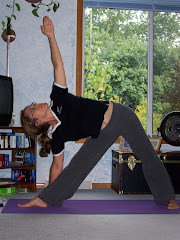
This was written a few months ago after working with Aadil Palkhivala:
The two hour drive from Milwaukee to Chicago took closer to three hours on a Tuesday morning in September. Fortunately I had left early with the idea of getting to Aadil Palkhivala’s workshop with plenty of time to set up my mat and release any tension from the city traffic. I envisioned calmly entering the room and creating a sacred place with my mat while slowly transitioning my mind from stop-and-go traveling to gaining a deeper understanding of yoga. Instead I stumbled in with literally two minutes to pee, toss down a mat, and grab a pencil for note taking. But this article is not about me, it’s about Aadil.
Picture a tall, large, and bald man, with a voice that can fill the room with tone, depth, and grandeur all at once. He always manages to maintain a sweet odor about him even when he sweats. As Aadil took his place at the teacher’s seat, the room of approximately fifty yogis grew respectfully quiet. As he sat on a foam block in virasana, his eyes closed and his breath steady and expansive. An energy lingered in the room that told me, this was not for show. He was going within to speak from a more meaningful place than the mind. He spoke from the heart.
We began with warming up our breath and joining the energy of the mind and pelvis to the heart center. The Gayatri mantra set the tone for higher truth to be a focal point of the practice.
Throughout this two hour workshop and then a three hour class several days later, Aadil did a fine job of intermixing lecture and asana. The first class included the use of the five vayus in standing poses. What amazed me was that we only did four standing postures and yet I felt the work in my legs and core for two or three days. It was not the quantity or difficulty of the poses that made this experience so unique. The poses were quite basic: trikonasana, parsvakonasana, virabhadrasana I, and virabhadrasana II. It was the quality and awareness that he skillfully guided the students to realize.
The vayus, or subsets of Prana, are directly related to the five elements: earth, air, ether, water, and fire. As Aadil encourages us to connect our bones to the earth with solidity and to lift from the arches through the perineum with fire, my body came alive and brought a new energy to the entire pose, which by the way I’ve been doing for almost a decade now. He showed how water gave the spreading action in parsvakonasana and virabhdrasana II contained all elements at once.
With a booming tone and zeal in his eyes as he curled his fingers and commanded, “Feel the fire!” My energy blazed and the connection of the body and environment was readily apparent.
Unlike dozens of other teachers I have worked with, Mr. Palkhivala does not just give lip service to the steps he outlines for asanas: mindful awareness, breath, and light. Plenty of yogis say something similar, but then focus mainly on taking the postures deeper and deeper with no real focus on what the mind or spirit are doing. As Aadil shared during our third, or so, time into a pose, “If you do not intend come into this asana with joy, you have no business doing it!” How very true and how frequently overlooked. One of the fundamental principles provided to us by Pantanjali is that of non-violence. If you cannot come into a pose with joy, violence comes all too easily. With joy, there is no violence.
Although these workshops provided a wonderful and articulate way of experiencing energy, breath, and life in the body, the real gem of working with Aadil is his life wisdom. Pearls of truth were released all throughout the class; constantly reminding the students of how asana is only a small part of yoga. “Yoga must use asana—if at all—to uncover and then live dharma. Otherwise asana is at best an exercise and at worst a means off your path.” All too often, I have seen popular yoga teachers lost in their own egos claiming that if we chant om a few times, their classes are spiritual.
Classes with this unique man include a reminder that asana is only a small part of yoga. Perhaps in an attempt to balance an asana-loving nation, I felt he downplayed the postures to the point that one might wonder why do them at all. (This is something I question with frequency in my own practice.) As if he read the question in my mind, during the opening of the second class, he shared, “Asana is done to connect to the energy all around us…. The purpose of asana is not to do more and more asana. It’s to do more and more life!” His voice rose with emphasis on the word life and I could feel a zest to be more, to live more fully growing inside of me.
Finally, Aadil quoted Mikhail Gorbachev as he prompted us all to discover and live our life’s purpose now, “If not me, who? If not now, when?”





